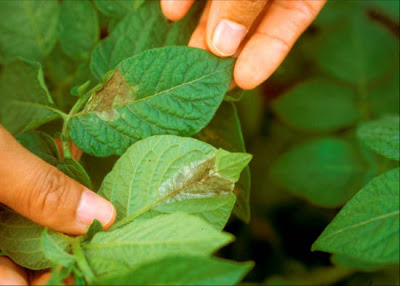
I must say, this worries me, whereas the H1N1 Flu business only concerns me. We have all heard about the tomato blight in the Eastern US this year, predominately, but not limited to, the northeast.
For certain, it ruined my tomato crop this year. If I had to depend on this year's garden to feed me, I would certainly starve this winter. I know the tomato blight is related to the potato blight, and just in the last few days, Wisconsin has confirmed potato blight in at least 3 different areas.
The disease can stay in the soil for years, but there are steps you can take for prevention. One step is fungacide spraying. The other is to cut plants off at the root, seal it in a plastic bag and let it dry in the sun before disposing of the whole package.
The Great Famine
The Great Famine (Irish: an Gorta Mór meaning "the great hunger") was a period of starvation, disease and mass emigration between 1845 and 1852 during which the population of Ireland was reduced by 20 to 25 percent. Approximately one million of the population died, and a million more emigrated away from Ireland's shores.
The proximate cause of famine was a potato disease commonly known as potato blight. Although blight ravaged potato crops throughout Europe during the 1840s, the impact and human cost was high in Ireland—where a third of the population was entirely dependent on the potato for food.
Prior to the arrival in Ireland of the disease Phytophthora infestans, commonly known as blight, there were only two main potato plant diseases. One was called 'dry rot' or 'taint' and the other was a virus, known popularly as 'curl'. According to W.C. Paddock however, Phytophthora infestans is an oomycete, not a fungus.
How and when the blight Phytophthora infestans arrived in Europe is still uncertain; according to some historians; however, it almost certainly was not present prior to 1842, and probably arrived in 1844. At least one of the sources of the infection suggests it may have originated in the northern Andes region of South America, Peru in particular. It was then conveyed to Europe on ships carrying bat guano, which was in great demand as a fertilizer on European and British farms.
In 1844 Irish newspapers carried reports concerning a disease which for two years had attacked the potato crops in America. According to one historian, a likely source was the eastern United States, where in 1843 and 1844 blight largely destroyed the potato crops.
Once it was introduced it spread rapidly. By late Summer and early Autumn of 1845 it had spread throughout the greater part of northern and central Europe. By mid-August, Belgium, Holland, northern France and southern England had all been stricken.
Crop loss in 1845 has been estimated from 33% to a high of 50%. In 1846, 75% of the harvest was lost to blight. The first deaths from starvation were recorded in the autumn of 1846.
Fortunately, in this country we are not as dependent on the potato (except for MickeyD's French Fries) as we are on wheat. But what if the wheat disease in Africa spreads here?
No comments:
Post a Comment
I'd love to hear what you think about my posts! We all learn together.